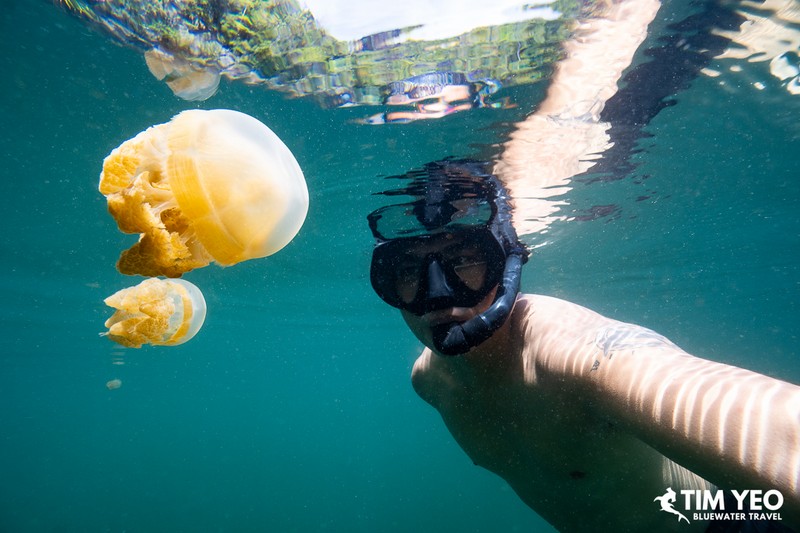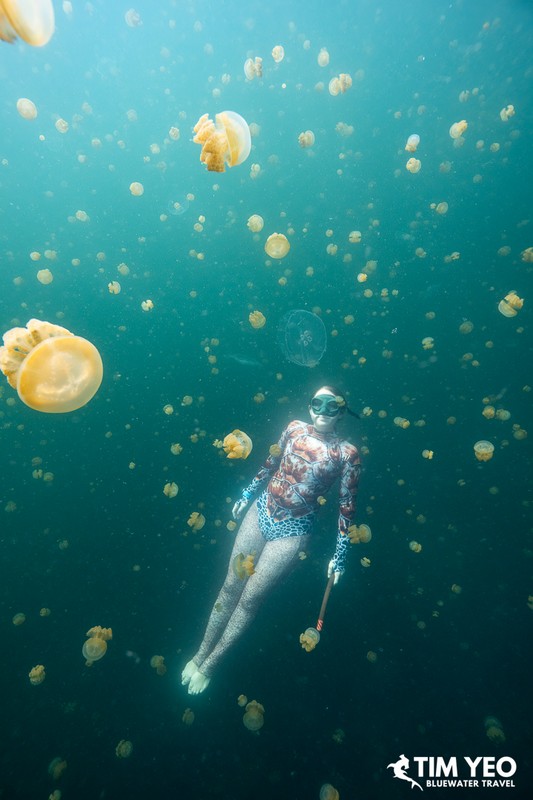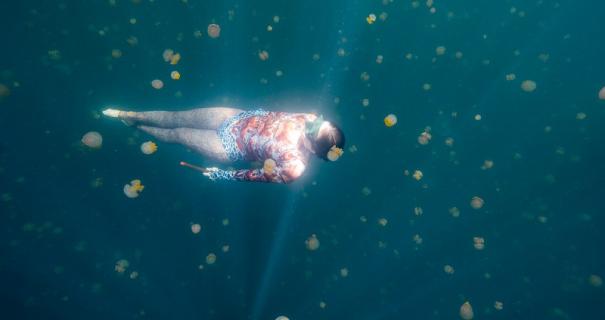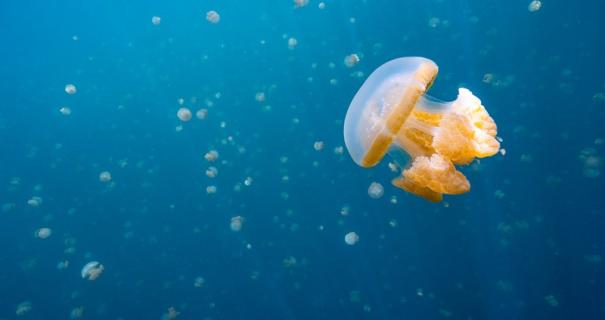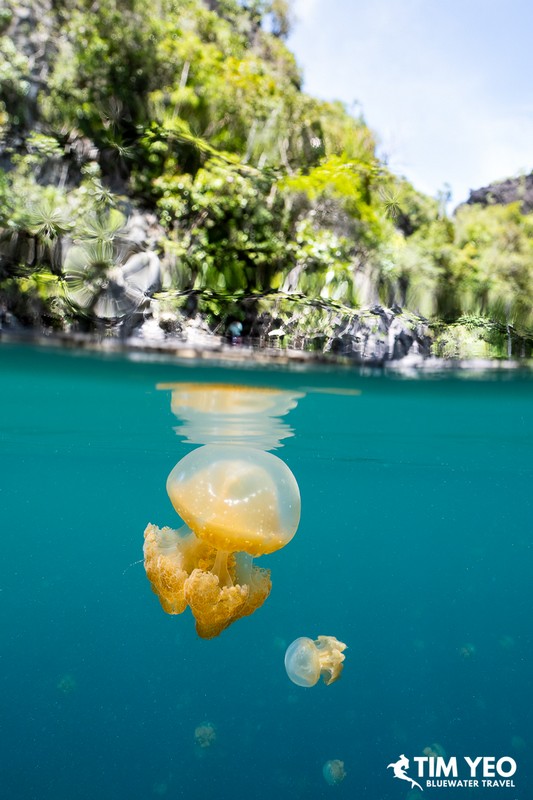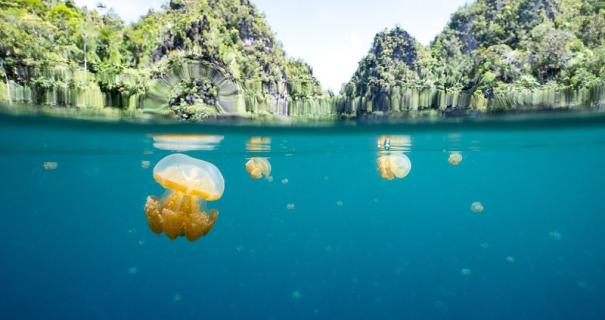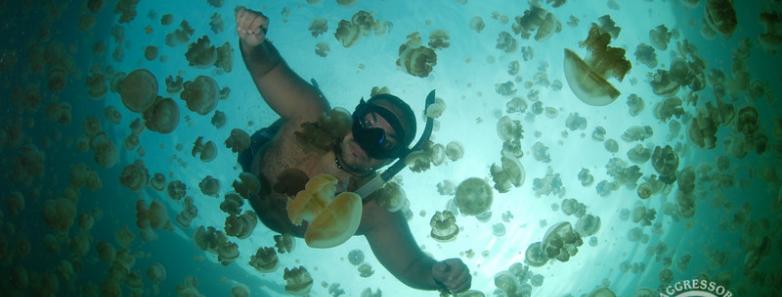Where to Swim with Jellyfish - and not get stung!
Between Koror and Peleliu in Palau’s Southern Lagoon, a weirdly wonderful inland lake is one of the South Pacific’s most unique underwater attractions. Visitors trek 20 minutes over a small, vegetation-covered hill to swim with millions of jellyfish in the appropriately named Jellyfish Lake. Jellyfish Lake is home to, quite literally, millions of jellyfish. At its peak in 2005, it was estimated that there were somewhere in the region of 30 million jellyfish living in the lake!
The majority of the jellyfish are of the Golden Jellyfish or Moon Jellyfish species, and over the 12,000 years the lake has existed, they have evolved in a very unusual way for jellyfish; they have lost their nematocysts or stinging cells. Since they have no natural predators in the lake, they don't need the ability to sting things in self-defense. The downside is that scuba diving isn't allowed in Jellyfish Lake due to high concentrations of hydrogen sulfide at depths greater than 15m/50ft. But that doesn't mean you can't get in the water; you have the opportunity to go snorkeling in the lake to get up close and personal with them and experience a swim like no other.
Jellyfish Lake
The lake itself doesn’t look like anything out of the ordinary, a 1,500-by-500-foot patch of dark blue in the surrounding jungle. Like many of the lakes in Palau, it is connected to the sea by a series of fissures and cracks worn into the limestone bedrock. This allows seawater from the nearby lagoon to filter into the top of the lake at high tide, creating a layer of nutrient-rich oxygenated water and ideal conditions for the jellyfish to thrive. At a depth of 50 feet, the water suddenly becomes anoxic, and the occurrence of hydrogen sulfide increases dramatically to the point where nothing can survive. Levels of hydrogen sulfide in the lake are eight times higher than is safe for humans to absorb, and so scuba diving is strictly prohibited.
The Jellyfish
Jellyfish Lake Palau is sufficiently isolated from nearby water sources that the jellyfish within the lake have evolved into unique species. There are two types of jellyfish found here: the golden jellyfish and the moon jellyfish. The golden jellyfish is closely related to the spotted jellyfish found in local lagoons; however, they have lost their spots and almost all of their appendages. They obtain a large part of their nutrition from symbiotic algae that live in their tissues and also from capturing zooplankton in the water column. The moon jellyfish are lesser in number and do not exhibit the same distinct daily migration patterns as the golden jellyfish. An absence of predators means that both types of jellyfish have lost their stinging cells and so appear non-stinging to all but the most sensitive skin.
Jellyfish Migration
The golden jellyfish found swimming in Jellyfish Lake display a behavior known as daily, or quotidian, migration. From early morning until around 9.30 am, they move from the mid-western end of the basin to the east, and then from early afternoon through until 3.30 pm, they move back again to the far western end. At sunset, they move slightly west back to the mid-western basin and then spend the night making repeated vertical movements between the surface and the deeper layer of water.
This pattern of behavior throughout the day ensures the jellyfish achieve maximum sun exposure to support the algae living in their tissue. They also rotate continuously in a counter-clockwise direction, presumably to ensure constant and even sun coverage for their algae. Trips to deeper water at night are to obtain nitrogen and other chemicals and also to support the algae.
How to Visit Palau
From the west coast of the US, there are several airlines offering 1-stop routes to Roman Tmetuchl International Airport (KOR) in Koror, Palau. Visitors can then choose to base themselves at a resort or spend some time on a liveaboard. Both options offer some great diving and a chance to explore Palau’s best dive sites.
Palau can be dived year-round, although the best time to visit is during the dry season from October through to May. As well as diving, visitors can explore the island’s rich military history or enjoy nature hikes, kayaking, or sport-fishing. If you have any questions about diving in Palau and even adding on a Jellyfish Lake experience, don't hesitate to reach out to us, we're always happy to help. You can email info@bluewaterdivetravel.com or call 310-915-6677.
Interested in diving in Palau? Check out Palau Dive Resorts or Liveaboards in Palau.
Photo by the Aggressor Fleet from Palau Aggressor II.
Further Reading:
Tips for photographing jellyfish in jellyfish lakes.


